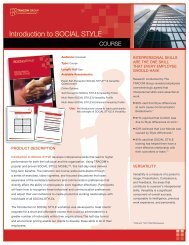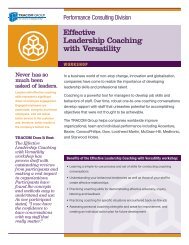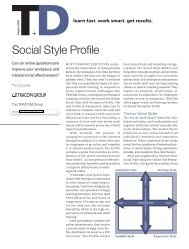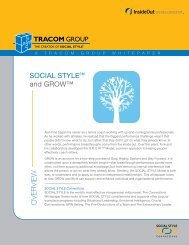Sales Concepts Guide Sneak Peek
Sales Concepts Guide Sneak Peek
Sales Concepts Guide Sneak Peek
Create successful ePaper yourself
Turn your PDF publications into a flip-book with our unique Google optimized e-Paper software.
TRACOM <strong>Sneak</strong> <strong>Peek</strong><br />
Excerpts from<br />
Improving <strong>Sales</strong><br />
Effectiveness with Versatility<br />
The Application of SociAl STylE<br />
concepts <strong>Guide</strong>
Table of Contents<br />
Page<br />
Introduction . . . . . . . . . . . . . . . . . . . . . . . . . . . . . . . . . . . . . . . . . . . . . . . . . . . . . . . . . . . . . . . . 1<br />
Why is it Important to Learn about SOCIAL STYLE and Versatility? . . . . . . . . . . . . . . . . 1<br />
How the SOCIAL STYLE Model <br />
is Unique . . . . . . . . . . . . . . . . . . . . . . . . . . . . . . . . . . . . 2<br />
<strong>Sales</strong> Survey. . . . . . . . . . . . . . . . . . . . . . . . . . . . . . . . . . . . . . . . . . . . . . . . . . . . . . . . . . . . . . 3<br />
Overview of this <strong>Guide</strong> . . . . . . . . . . . . . . . . . . . . . . . . . . . . . . . . . . . . . . . . . . . . . . . . . . . . . 4<br />
SOCIAL STYLE Fundamentals . . . . . . . . . . . . . . . . . . . . . . . . . . . . . . . . . . . . . . . . . . . . . . . 5<br />
Sampling the Personality Pie. . . . . . . . . . . . . . . . . . . . . . . . . . . . . . . . . . . . . . . . . . . . . . . . . 5<br />
The “Say and Do” Standard. . . . . . . . . . . . . . . . . . . . . . . . . . . . . . . . . . . . . . . . . . . . . . . . . . 6<br />
Predicting Behaviors . . . . . . . . . . . . . . . . . . . . . . . . . . . . . . . . . . . . . . . . . . . . . . . . . . . . . . . 7<br />
Behaving with Style. . . . . . . . . . . . . . . . . . . . . . . . . . . . . . . . . . . . . . . . . . . . . . . . . . . . . . . . 8<br />
Assertiveness . . . . . . . . . . . . . . . . . . . . . . . . . . . . . . . . . . . . . . . . . . . . . . . . . . . . . . . . . . . 8<br />
Responsiveness. . . . . . . . . . . . . . . . . . . . . . . . . . . . . . . . . . . . . . . . . . . . . . . . . . . . . . . . . 10<br />
The SOCIAL STYLE Model <br />
. . . . . . . . . . . . . . . . . . . . . . . . . . . . . . . . . . . . . . . . . . . . . . . . 12<br />
Dimensions of Behavior . . . . . . . . . . . . . . . . . . . . . . . . . . . . . . . . . . . . . . . . . . . . . . . . . . . 12<br />
Showing Your Own Style . . . . . . . . . . . . . . . . . . . . . . . . . . . . . . . . . . . . . . . . . . . . . . . . . . 12<br />
Creatures of Habit . . . . . . . . . . . . . . . . . . . . . . . . . . . . . . . . . . . . . . . . . . . . . . . . . . . . . . . . 17<br />
Unlocking the Keys to SOCIAL STYLE . . . . . . . . . . . . . . . . . . . . . . . . . . . . . . . . . . . . . . 18<br />
Tension Management . . . . . . . . . . . . . . . . . . . . . . . . . . . . . . . . . . . . . . . . . . . . . . . . . . . . . . . 19<br />
Turning the Tension Channel. . . . . . . . . . . . . . . . . . . . . . . . . . . . . . . . . . . . . . . . . . . . . . . . 19<br />
Tension: Motivator or Instigator? . . . . . . . . . . . . . . . . . . . . . . . . . . . . . . . . . . . . . . . . . . . . 20<br />
Getting Run Over by “Backup Behavior”. . . . . . . . . . . . . . . . . . . . . . . . . . . . . . . . . . . . . . 21<br />
Avoiding the Need for Toxic Clean-Ups . . . . . . . . . . . . . . . . . . . . . . . . . . . . . . . . . . . . . . . 22<br />
Versatility . . . . . . . . . . . . . . . . . . . . . . . . . . . . . . . . . . . . . . . . . . . . . . . . . . . . . . . . . . . . . . . . . 24<br />
Selling in the Third Dimension . . . . . . . . . . . . . . . . . . . . . . . . . . . . . . . . . . . . . . . . . . . . . . 24<br />
Support and Respect—A Necessary Ingredient for <strong>Sales</strong> Effectiveness. . . . . . . . . . . . . . . 25<br />
Gaining Support and Respect—One Step at a Time . . . . . . . . . . . . . . . . . . . . . . . . . . . . . . 27<br />
Next Step . . . . . . . . . . . . . . . . . . . . . . . . . . . . . . . . . . . . . . . . . . . . . . . . . . . . . . . . . . . . . . . . . 28<br />
FAQs . . . . . . . . . . . . . . . . . . . . . . . . . . . . . . . . . . . . . . . . . . . . . . . . . . . . . . . . . . . . . . . . . . . . 29<br />
© The TRACOM Corporation, All Rights Reserved.<br />
CONCEPTS<br />
GUIDE
Introduction<br />
WHY IS IT IMPORTANT TO LEARN ABOUT<br />
SOCIAL STYLE SM<br />
AND VERSATILITY?<br />
This guide is designed to teach you about<br />
SOCIAL STYLE and Versatility concepts<br />
and how they can help you develop skills to<br />
become a more effective salesperson. By applying<br />
the SOCIAL STYLE and Versatility concepts in<br />
this guide, you can develop better relationships with<br />
your customers and get more done, faster, with less<br />
effort. Plus, your customers will most likely<br />
increase their levels of support and respect for you.<br />
Simply stated, here’s how it works. You have<br />
preferred ways to act and interact with your<br />
customers. For example, when you begin the sales<br />
process you may prefer to move fast, gather just the<br />
necessary facts, contact people, and get things<br />
going right away; or, you may prefer to take things<br />
slower as you sort out the details, consider<br />
alternatives, and contemplate the consequences of<br />
taking one course of action versus another. These<br />
behavioral preferences and patterns of behavior are<br />
a part of your SOCIAL STYLE.<br />
Your customers also have their own behavioral<br />
preferences or SOCIAL STYLE. As you know from<br />
past interactions their SOCIAL STYLE can be quite<br />
different than your own. How effective you are with<br />
your customers depends on how you take their<br />
preferences into account, and how well you control<br />
your own. Your impact and effectiveness on your<br />
customers is a result of another key concept,<br />
Versatility.<br />
Consider the variety of people you call on. Perhaps,<br />
one speaks loudly and prefers to dominate the sales<br />
conversation; another is highly focused on making<br />
the purchase and getting the deal done; another<br />
goes out of his way to be friendly and often ends up<br />
talking about matters unrelated to the sale. These<br />
© The TRACOM Corporation, All Rights Reserved.<br />
and many other characteristic ways of acting and<br />
interacting with people are expressions of a<br />
person’s SOCIAL STYLE.<br />
Your success in selling to a diverse range of<br />
customers depends on: your technical skills as a<br />
salesperson; specialized knowledge about your<br />
products or services; and, your ability to make your<br />
relationships mutually productive. The essence of<br />
Improving <strong>Sales</strong> Effectiveness with Versatility, is<br />
how you increase the interpersonal effectiveness<br />
and productivity between you and your customers<br />
and how you earn their support and respect.<br />
Improving <strong>Sales</strong> Effectiveness with Versatility can<br />
also help you effectively plan and prepare for<br />
customer interactions. Approach customers and<br />
analyze their needs, present results, handle<br />
objections and gain their commitment. 1<br />
You can<br />
learn to resolve, or even head off, unnecessary<br />
conflict caused by “interpersonal friction” that may<br />
arise during the give-and-take of the sales process.<br />
1<br />
CONCEPTS<br />
GUIDE<br />
“Commitment” refers to any significant decision you ask a<br />
customer to make such as: making a decision to purchase the<br />
product or service you sell or entering into an agreement with<br />
you or your organization.<br />
1
Introduction Identifying the SOCIAL STYLE of your Customers<br />
sales survey<br />
A TRACOM study surveyed recent SOCIAL<br />
STYLE training participants, who worked in sales,<br />
to determine how effective SOCIAL STYLE had<br />
been in their daily sales activities.<br />
The survey questions focused on tasks specific<br />
to salespeople including developing relationships<br />
with customers, gaining customer trust, and<br />
closing sales.<br />
Because the sales profession relies heavily on<br />
solid relationships, TRACOM wanted to research<br />
how SOCIAL STYLE training could contribute to<br />
better relationships and, ultimately, more sales.<br />
© The TRACOM Corporation, All Rights Reserved.<br />
Summary of Findings<br />
CONCEPTS<br />
GUIDE<br />
TRACOM’s study found that SOCIAL STYLE<br />
training could dramatically impact a salesperson’s<br />
ability to create more positive relationships with<br />
current and potential customers.<br />
A majority of the surveyed salespeople felt that<br />
SOCIAL STYLE training helped them establish<br />
better relationships and gain trust with customers<br />
and prospects.<br />
Over half of the survey participants felt that as a<br />
direct result of SOCIAL STYLE training, they<br />
were able to close sales they otherwise might not<br />
have. The chart below illustrates the key findings.<br />
EFFECTIVENESS OF SOCIAL STYLE FOR SALESPEOPLE<br />
key findings* percentage<br />
More conscious about how their behavior impacts their customers 94%<br />
Applied SOCIAL STYLE to their sales job 93%<br />
Developed more positive relationships with customers 92%<br />
Believe that their customers now have a greater sense of confidence and trust in them 87%<br />
Increased ability to influence or persuade customers or prospects 87%<br />
Improved ability to gain ongoing sales 78%<br />
Build relationships with prospects more quickly 76%<br />
Customers now more willing to disclose relevant information 75%<br />
Convert prospects to customers more quickly 69%<br />
Closed sales they otherwise might not have 58%<br />
*TRACOM Corporation (2006), Centennial, CO. Visit www.tracomcorp.com for research and whitepapers.<br />
The percentage reflects salespeople who either strongly agreed or agreed to the statements.<br />
3
SOCIAL STYLE Fundamentals<br />
SAMPLING THE PERSONALITY PIE<br />
As an individual, you have a unique<br />
personality made up of a jumbled<br />
collection of emotional patterns, mental<br />
processes and thought patterns, values, and<br />
behavior patterns which are all influenced by<br />
genetics and personal experience. Accurately<br />
describing and explaining your personality would<br />
not just be difficult, it would be impossible.<br />
It’s little wonder that great minds like Albert<br />
Einstein stuck to simpler tasks like figuring out the<br />
nature of matter and energy in the universe! The<br />
SOCIAL STYLE Model, following Einstein’s<br />
wise example, doesn't try to figure out your<br />
personality either.<br />
Style is like the crust of the<br />
personality pie. It’s the part<br />
that can be seen — the<br />
observable behavior.<br />
© The TRACOM Corporation, All Rights Reserved.<br />
PERSONALITY PIE<br />
CONCEPTS<br />
GUIDE<br />
SOCIAL STYLE deals with just your behaviors,<br />
that part of your personality that can be<br />
objectively observed. The word personality comes<br />
from the Latin word persona, which means<br />
“mask.” This term is appropriate, since<br />
personality comprises both visible and hidden<br />
qualities. In a simple analogy, personality can be<br />
compared to a pie. The inside of the pie, like much<br />
of your personality, is out of direct view and<br />
contains a mix of ingredients that give the pie a<br />
unique texture and flavor. Behavior is like the<br />
crust, the outer part of the pie that everyone can<br />
see and describe in more or less the same way.<br />
Like the crust of the Personality Pie, SOCIAL<br />
STYLE behaviors are particular patterns of action<br />
that people can observe and agree upon for<br />
describing a person’s usual behavior.<br />
The personality includes;<br />
inner qualities, attitudes,<br />
aptitudes, dreams, values,<br />
and abilities.<br />
5
THE “SAY AND DO” STANDARD<br />
Observable behaviors are what you say (verbal<br />
behaviors) and do (non-verbal behaviors) with no<br />
judgments by the observer as to why. Observable<br />
behaviors are interactions between two people<br />
whose behaviors can be observed and verified by<br />
others. The interaction could be between you and<br />
your customer or between you and a prospective<br />
buyer. Notice that the “Say and Do” Behaviors<br />
listed below are not “either-or” propositions.<br />
Rather, they represent continuums, for example,<br />
from quieter to louder, or from less to more direct<br />
eye contact.<br />
6<br />
SOCIAL STYLE Fundamentals<br />
OBSERVABLE “SAY AND DO” BEHAVIORS<br />
Quieter<br />
Slower paced<br />
More facially controlled<br />
Less inflected voice<br />
Less direct eye contact<br />
More casual posture<br />
Leans back<br />
-<br />
-<br />
-<br />
-<br />
-<br />
-<br />
-<br />
Louder<br />
Faster paced<br />
More facially animated<br />
More inflected voice<br />
More direct eye contact<br />
More rigid posture<br />
Leans forward<br />
© The TRACOM Corporation, All Rights Reserved.
Responsiveness<br />
Responsiveness is a dimension of observable<br />
behavior that measures the degree to which others<br />
see you as tending to control or emote when<br />
interacting, that is, the degree to which you<br />
display, or don’t display, your feelings and<br />
emotions. Note that, as used here, “control” does<br />
not mean that the person controls the situation and<br />
“emote” does not mean that the person's emotions<br />
are dramatic or “out of control.”<br />
10<br />
Emotion<br />
In<br />
Voice<br />
SOCIAL STYLE Fundamentals<br />
More Controlling<br />
More Emoting<br />
As with the Assertiveness Scale, you can use the<br />
various verbal and non-verbal clues shown in the<br />
Behaviors on the Responsiveness Scale to<br />
identify a pattern in a person's behaviors, based on<br />
what you observe a person actually saying or<br />
doing over time.<br />
BEHAVIORS ON THE RESPONSIVENESS SCALE<br />
Verbal Behaviors Non-Verbal Behaviors<br />
Monotone Task Facts/Data<br />
Subjects<br />
of<br />
Speech<br />
Form<br />
of<br />
Descriptives<br />
Inflection People Opinions/Stories<br />
EMOTES CONTROLS<br />
Less<br />
Use of<br />
Hands<br />
More<br />
More Controlling<br />
Rigid<br />
Body<br />
Posture<br />
Casual<br />
More Emoting<br />
Controlled<br />
Facial<br />
Expression<br />
Animated<br />
© The TRACOM Corporation, All Rights Reserved.
The SOCIAL STYLE Model TM<br />
The Driving Style<br />
“Let's get it done, now.”<br />
People with a Driving Style are seen by others as<br />
active, forceful, and determined. People with a<br />
Driving Style are direct; they initiate social<br />
interaction and they focus their efforts and the<br />
efforts of others on the goals and objectives that<br />
they wish to get accomplished now. People with a<br />
Driving Style are typically described by others as<br />
cool, less personable, guarded and, at times, aloof,<br />
as they typically do not openly show their feelings<br />
or reveal the depth of their emotions.<br />
People seen as having a Driving Style appear to:<br />
� Know what they want<br />
� Have little difficulty conveying their<br />
conclusions about anything that concerns them<br />
� Focus on the immediate time frame with<br />
relatively little concern for the past or future<br />
� Be swift, efficient and to the point<br />
� Be impatient with delays<br />
� Show less concern for the feelings of others or<br />
for personal relationships<br />
� Be harsh, severe or critical due to their limited<br />
attention to relationships<br />
� Be efficient and decisive<br />
� Seek control through the use of power<br />
� Use time in a disciplined manner<br />
© The TRACOM Corporation, All Rights Reserved.<br />
DRIVING STYLE HIGHLIGHTS<br />
� Faster paced<br />
� Make efforts to set the pace<br />
� Seem less concerned for the value in<br />
relationships<br />
� Work in the present time frame<br />
� Tend to direct the actions of others whether or<br />
not they are the leader<br />
� Tend to avoid inaction<br />
CONCEPTS<br />
GUIDE<br />
13
SELLING IN THE THIRD DIMENSION<br />
With a basic understanding of the two<br />
dimensions of behavior, Assertiveness<br />
and Responsiveness that form the<br />
SOCIAL STYLE positions, you should now have<br />
a much better understanding of the behavioral<br />
tendencies of your customers in any given<br />
situation and you should be able to take actions to<br />
work with them more effectively. However, there<br />
is one more dimension to the SOCIAL STYLE<br />
Model. This dimension, Versatility, is critical to<br />
creating productive and successful interpersonal<br />
interactions.<br />
24<br />
Versatility<br />
The Versatility Dimension is not behavioral but<br />
instead reflects the impact or effect your behavior<br />
has on the amount of support and degree of respect<br />
(sometimes called “social endorsement”) you earn<br />
from others, such as co-workers and customers.<br />
Unlike Assertiveness and Responsiveness, which<br />
are relatively stable and consistent over time, the<br />
support and respect that you earn from your<br />
customers can increase or decrease depending on<br />
your willingness to work toward mutually<br />
productive interactions. Also, with Versatility, the<br />
more support and respect you earn, the more<br />
effective you are likely to be, unlike the behavioral<br />
dimensions where there is no best place to be, no<br />
good or bad style.<br />
VERSATILITY DIMENSION<br />
Behaviors Seen as<br />
Focusing on<br />
My Tension<br />
Versatility<br />
Low Me dium High<br />
To increase your sales effectiveness, you must have<br />
the support and respect of your customers. Your<br />
particular style of behavior matters less than how<br />
you actually use your behavior to gain that support<br />
and respect. Your ability to earn your customers’<br />
support and respect is reflected in their perception<br />
of your Versatility, that is, your ability to relate to<br />
them in a way that makes them feel comfortable,<br />
helps them to achieve their purchase objective, to<br />
satisfied with you and the sales process. In fact,<br />
simply being seen as genuinely trying to help them<br />
succeed in the purchase process can increase your<br />
Versatility.<br />
A critical aspect of Versatility in the sales process is<br />
whether your customers see you as tending to focus<br />
on reducing your own tension or on reducing their<br />
tension. <strong>Sales</strong> people who are not overly focused on<br />
meeting their own style Need and are versatile<br />
enough to adapt their behaviors to helping<br />
customers to meet their style Needs are seen as<br />
having higher Versatility.<br />
The greater your willingness to accommodate<br />
others and adapt to situations, the greater likelihood<br />
of a higher Versatility score. TRACOM’s research<br />
shows that higher Versatility scores lead to<br />
interpersonal effectiveness and success.<br />
Behaviors Seen as<br />
Focusing on<br />
Others' Tension<br />
© The TRACOM Corporation, All Rights Reserved.











